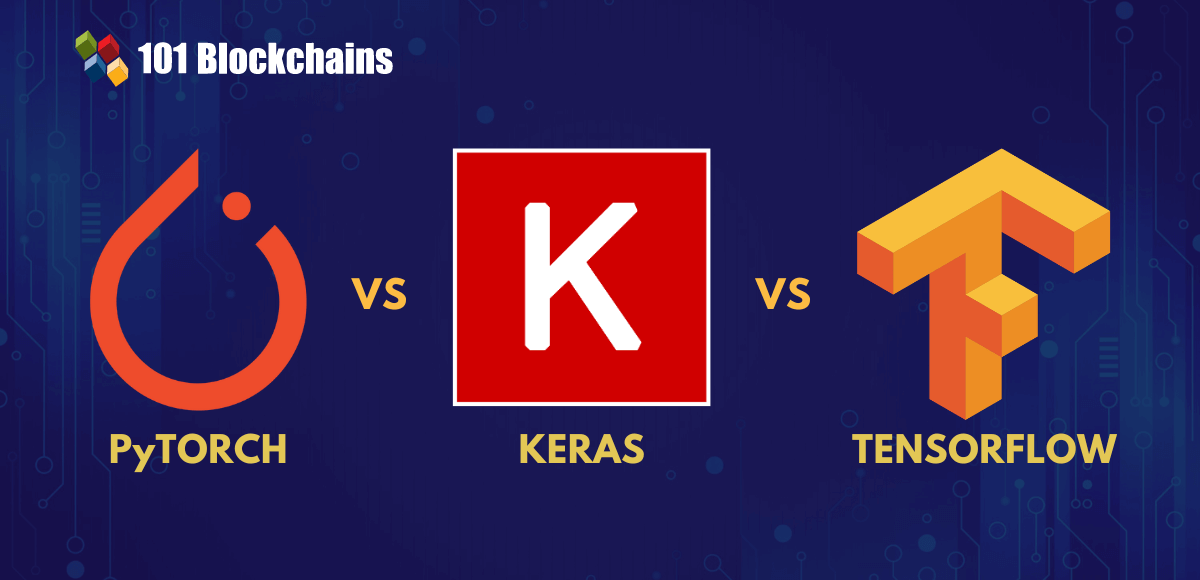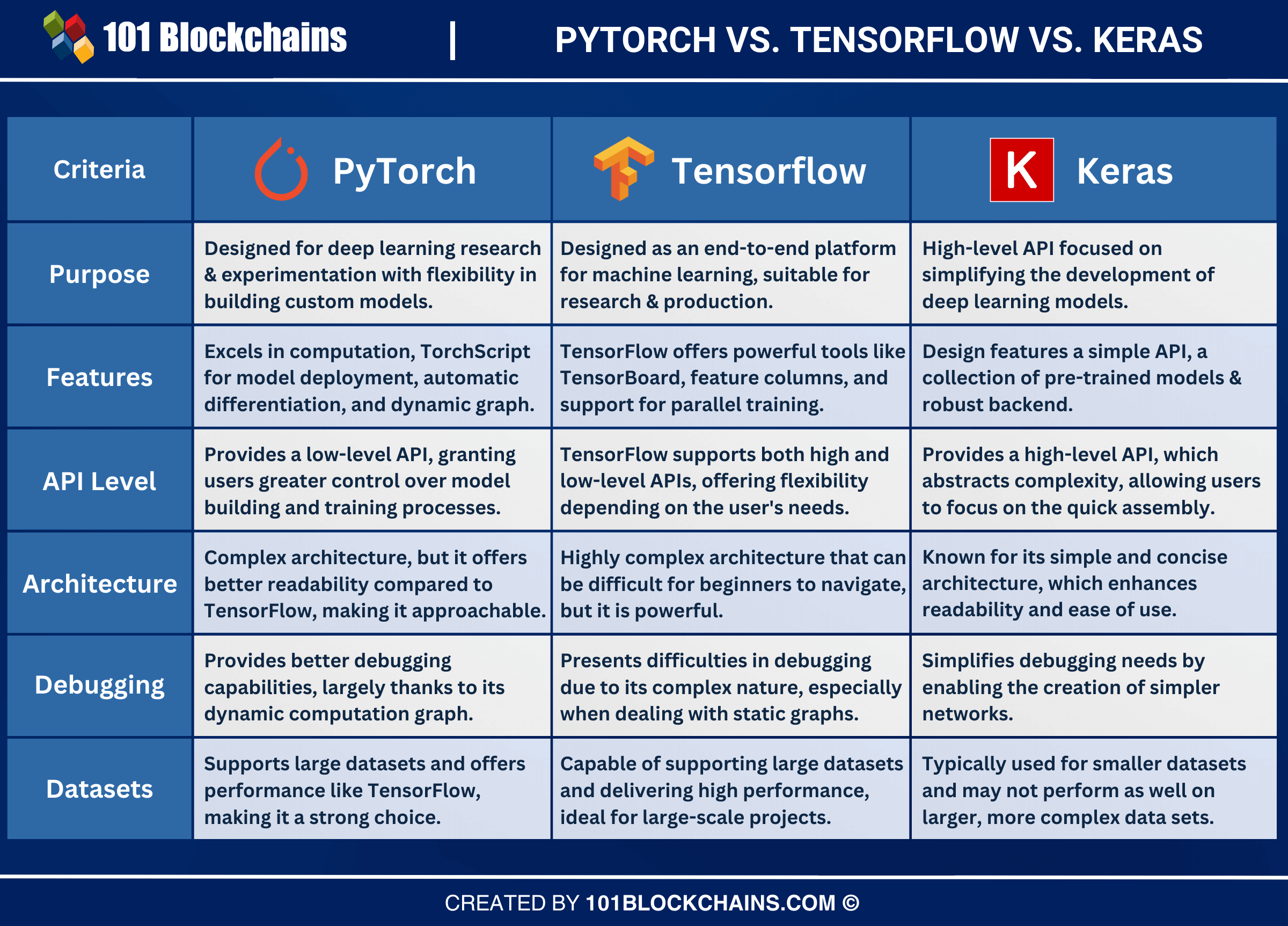PyTorch vs TensorFlow vs Keras: Key Differences

Deep learning frameworks make it easier to develop and deploy machine learning models. These frameworks support learning, training models, and implementation in AI systems. The three most prominent deep learning frameworks today are PyTorch, Keras, and TensorFlow.
Finding the best direction for your AI project will require a PyTorch vs TensorFlow vs Keras comparison. AI researchers and practitioners use frameworks according to their needs, leveraging their unique strengths in different fields. Machine learning practitioners and engineers need frameworks that reduce the technical burden associated with programming ML and deep learning models.
For example, machine learning frameworks help you implement models without having to delve deeper into the mathematical foundations of the algorithms. Let’s unpack the differences between these frameworks based on some important aspects that will help you make the right decision.

What are TensorFlow, PyTorch, and Keras?
Deep learning and machine learning are important subsets of artificial intelligence that power a variety of AI use cases. These frameworks can help support a variety of applications, such as speech recognition, decision making, language translation, and object detection. Before diving into the TensorFlow vs Keras vs PyTorch comparison, it is important to learn more about the frameworks and their strengths. This comparison can help you avoid confusion between these frameworks and find the right one for your AI project.
TensorFlow is a major end-to-end open source deep learning framework created by Google. It is popular for its extensive documentation and training support, multiple levels of abstraction, scalable production and deployment alternatives, and compatibility with a variety of platforms. The PyTorch vs TensorFlow comparison highlights the fact that TensorFlow is a popular neural network library.
It is useful for data flow programming in a wide range of tasks. This framework guarantees better scalability and flexibility. You can find a wide range of stable toolkits and libraries in TensorFlow, and you can also get support from a thriving community. It offers the advantage of accessing and deploying machine learning models on a variety of platforms.
PyTorch is the newest entry in the machine learning frameworks. It was created by the Facebook AI research group and was open sourced in 2016. The features of PyTorch have helped it gain recognition for its efficiency, simplicity, and flexibility. With an insight into the features of PyTorch, you can get a better impression of the differences between Keras and PyTorch.
It can help engineers debug and experiment with various algorithms with the most efficient features. Other notable advantages of PyTorch include GPU acceleration and flexibility for integration with Python. PyTorch offers many other promising features such as dynamic computational graphs, ease of use, simplicity, and efficient memory usage.
Keras is a popular, high-level open source neural network API. It is geared towards deep learning and offers a user-friendly interface along with the flexibility to use the code on a variety of systems. The Keras vs TensorFlow comparison also highlights the compatibility of Keras and TensorFlow. The framework has been integrated and adopted into TensorFlow, ensuring that it is accessible to TensorFlow users.
It can also work effectively with Microsoft Cognitive Toolkit or CNTK. Keras’s main focus is on deployability, debugging speed, maintainability, and code elegance and conciseness. It supports easier iteration with a smaller, more readable code base.
Take your first steps in learning artificial intelligence with AI flashcards
What are the differences between TensorFlow, PyTorch, and Keras?
Comparing TensorFlow, PyTorch, and Keras is essential to finding out which option is best for you. However, because each framework has powerful features, it can be difficult to distinguish between the three frameworks. Here is an overview comparing TensorFlow, PyTorch, and Keras based on various factors.
The most important factor in answering a question like “Which is better, Keras or PyTorch or TensorFlow?” is to focus on the core features of the frameworks. Reviewing the core features of TensorFlow, PyTorch, and Keras can help you identify the features for your machine learning project.
TensorFlow offers promising features such as TensorBoard, parallel learning, and feature columns. It also facilitates easier learning on CPUs and GPUs. TensorBoard serves as a set of interactive visualization tools that help you understand, debug, and optimize TensorFlow programs.
Feature columns in TensorFlow are high-level abstractions that help transform raw data into a format that is suitable for machine learning. TensorFlow also supports parallel learning, which includes distributed computing, to reduce training times.
Keras stands out in the PyTorch vs TensorFlow vs Keras debate due to its various features. It provides a user-friendly API that offers a better outlook for getting familiar with deep learning. Keras also provides backend support with the strengths of Theano, TensorFlow, and Microsoft CNTK. It is a high-level API that can support faster model development within a few lines of code. On top of that, Keras provides a collection of pre-trained models that can be used for various machine learning tasks.
PyTorch is also a powerful framework tailored for machine learning and deep learning workloads. Key features of PyTorch include Tensor computations, dynamic graph computations, TorchScript, and automatic differentiation. PyTorch provides multidimensional arrays in the form of Tensors that can be run on GPUs to achieve faster computations.
The framework also leverages dynamic computational graphs, which can provide flexibility in model development and modification. TorchScript is a reliable feature for serializing PyTorch models, ensuring compatibility with C++ environments and production readiness. PyTorch also leverages automatic differentiation along with gradient computation to simplify neural network backpropagation and training.
Learn the real potential of AI and best practices for using AI tools through our AI for Business course.
Another important factor when comparing TensorFlow, PyTorch, and Keras is the API level of the frameworks.
Comparing PyTorch and TensorFlow, TensorFlow has the advantage of providing convenient use of high-level and low-level APIs.
On the other hand, PyTorch is a low-level API that supports working directly with array expressions, which has made it more popular in academic research and deep learning applications that require optimization of user-defined expressions.
Keras is a high-level API that can run on Theano, TensorFlow, and CNTK. It has become a preferred choice for machine learning researchers and developers due to its simple syntax that ensures easier usability and faster development.

The architecture of machine learning frameworks is also an important factor in comparing them. In the TensorFlow vs Keras vs PyTorch debate, it can help you figure out which framework offers better usability. TensorFlow has the most complex architecture and can be difficult for beginners to use.
On the other hand, PyTorch also has a complex architecture, which limits its readability, especially for beginners.
Keras stands out as the best choice in terms of architecture because of its simplicity. In addition, it is concise and provides better readability.
Debugging is a critical requirement for machine learning frameworks that are required to create error-free ML models. Comparing Keras and TensorFlow suggests that TensorFlow may not be suitable for projects that require a comprehensive evaluation of the project before deployment. TensorFlow is incredibly frustrating to debug.
Keras is similar to TensorFlow in terms of debugging, but from a different perspective. Since it is a simple network, debugging may not be necessary in most cases.
PyTorch emerges as the winner due to its impressive debugging capabilities compared to Keras and TensorFlow.
Enroll in the ChatGPT Fundamentals course today and dive into the world of rapid engineering with hands-on demos.
The next important factor to consider when comparing Keras vs PyTorch is the type of datasets they support. Interestingly, TensorFlow and PyTorch are on the same page in terms of supported datasets. Both frameworks support large datasets and promise high performance.
Keras, on the other hand, is suitable for running on smaller datasets.
Here’s an overview of the differences between TensorFlow, PyTorch, and Keras.

Last words
Finding answers to questions like “Which is better, Keras, PyTorch, or TensorFlow?” will help you understand the unique strengths of each framework. You can use aspects like architecture, datasets, API level, and debugging capabilities to find the ideal machine learning framework.
These factors can serve as an ideal benchmark to compare frameworks and determine the best choice. Interestingly, TensorFlow, PyTorch, and Keras are the most used frameworks by machine learning researchers and developers. Learn more about their unique features, advantages, and limitations to find the framework that best suits your project requirements.

1.png)


